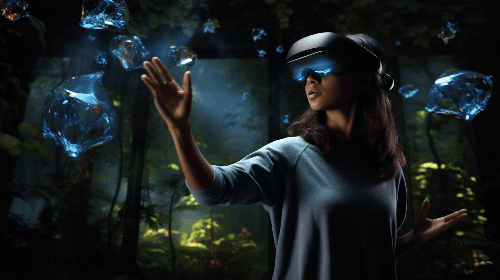NVIDIA’s Pioneering Move with Generative AI in XR Development
In an era where technology is consistently advancing at an unprecedented pace, two emerging realms – XR (Extended Reality) and AI (Artificial Intelligence) – are making waves. Notably, NVIDIA stands at the forefront of this evolution, intertwining the power of Generative AI (GenAI) with XR technologies, catalyzing innovation in both sectors.
The Convergence of XR and GenAI
Historically, XR was considered the tangible interface of AI, akin to how MR (Mixed Reality) becomes the sensory representation of artificial intelligence. Rather than being adversaries, XR and AI can work hand-in-hand to augment experiences for users across various platforms.
While the Metaverse has been a focal point for many, GenAI has garnered significant attention recently. Notably, technology giants such as Microsoft are setting out visionary plans to sculpt the industrial Metaverse within the next year. Nevertheless, the application of GenAI extends beyond immersive products. In the realm of XR development, GenAI is emerging as an indispensable tool, streamlining the creation process of XR solutions, from AR (Augmented Reality) to VR (Virtual Reality) and MR.
NVIDIA’s Mastery with GenAI in XR
NVIDIA’s Omniverse is a testament to their commitment in this space. As the vice president of Omniverse, Rev Lebaredian, elucidated, the latest update introduces XR developers to GenAI-optimized workflows. By integrating OpenUSD – a versatile graphic framework – NVIDIA amplifies its GenAI services, engaging platforms like Cesium, Convai, Move AI, SideFX Houdini, and Wonder Dynamics.
What does this mean for developers? Enhanced tools in Omniverse enable the construction of expansive, intricate world-scale simulations, establishing a digital playground for industrial applications.
Omniverse’s Multifaceted GenAI Upgrades
Omniverse is not just limited to GenAI workflows. It also introduces the USD Composer – a tool that allows developers to sculpt extensive scenes using the OpenUSD architecture. Another groundbreaking feature is Audio2Face, a GenAI-driven programming interface that breathes life into XR characters, offering realistic facial animations extracted from sound bytes.
Inclusivity is also on NVIDIA’s radar. With new developer templates and resources, they aim to reduce barriers to entry, welcoming a broader spectrum of developers into the fold. Furthermore, the incorporation of Pixar’s graphics format further solidifies Omniverse’s appeal across a range of industry applications.
Continuous Evolution of the Omniverse
But NVIDIA isn’t stopping there. The Omniverse Kit Extension Registry is expanding, infused with modular features that simplify the app creation process. Leveraging the prowess of Ada Lovelace, NVIDIA is refining Omniverse’s efficiency, bringing forth features like an AI denoiser for impeccable “real-time 4K path tracing.” Also, the integration of XR tools allows developers to conceive spatial environments, offering a more immersive experience akin to Apple’s Vision Pro.
NVIDIA’s Unwavering Support for XR Development
NVIDIA’s collaboration with Varjo in launching ray-tracing tools on the Omniverse platform underscores their commitment to premium quality. As Marcus Olssen, Director of Software Partnerships at Varjo, highlighted, these tools transform the visual experiences within VR, setting a new gold standard.
At the GPU Technology Conference 2023, NVIDIA unveiled the CloudXR 4.0 platform, which further streamlines XR deployments. This provides developers an expansive platform, from the cloud to 5G mobile compute edge (MEC), ensuring that innovation remains at the core of every endeavor.
Conclusion
NVIDIA’s endeavors in blending Generative AI with XR are reshaping the technological landscape. By fostering collaboration, nurturing innovation, and setting industry benchmarks, they’re crafting the future, today.


